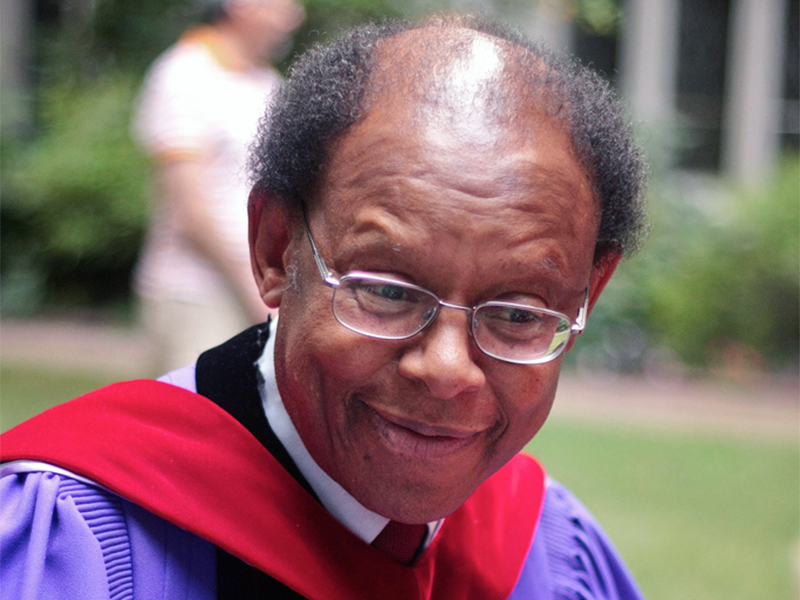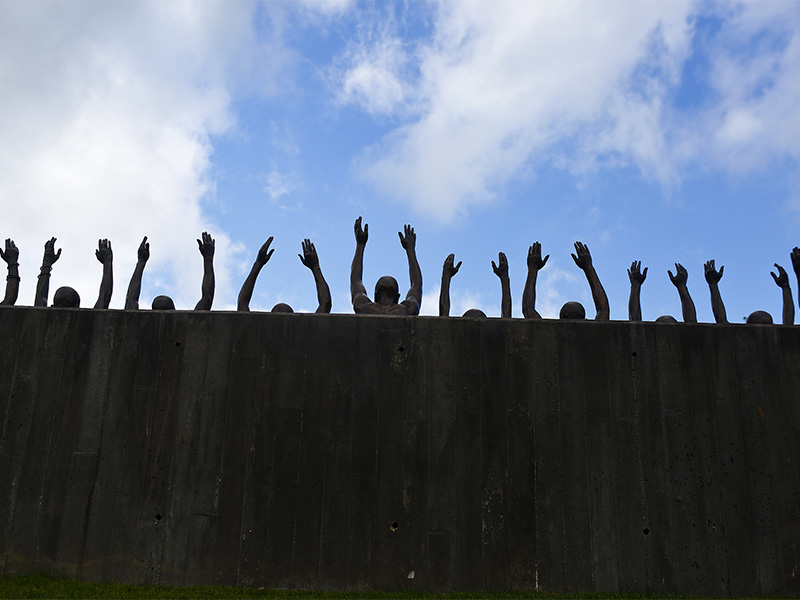

This photo shows a bronze statue called “Raise Up” that is part of the display at the National Memorial for Peace and Justice, a new memorial to honor thousands of people killed in racist lynchings, on April 23, 2018, in Montgomery, Ala. The national memorial, which aims to teach about America’s past in hope of promoting understanding and healing, opened April 26. (AP Photo/Brynn Anderson)
(RNS) — On April 26 America received its first-ever memorial dedicated to the more than 4,000 victims of lynching in this country. Two days later, James Cone, the acclaimed author of “The Cross and the Lynching Tree,” died.
The opening of the National Memorial for Peace and Justice in Montgomery, Ala., and the passing of a theological legend coincide in ways that provoke thoughts about the spiritual implications of American racism. How do the cross and the lynching tree represent both injustice and redemption? How do we confront the dark truths of our past to create a future that is brighter for all people?
At the lynching memorial, rusted iron columns hang suspended from the ceiling. Each column, numbering about 800 in total, represents a county where a lynching occurred. Many feature multiple names as the number of human beings killed for their color stacks up to create the crushing weight of an undeniable, yet underrepresented, history.
Visitors to the lynching memorial learn that racial terrorists designed lynching as a public spectacle to intimidate black people.
“Racial terror was characterized by extreme violence: victims were tortured for hours before their brutalized bodies were left out on display to traumatize other black people,” one placard reads. It goes on to explain that members of the mob often posed for photographs next to the mutilated corpses of their victims. These horrific displays served as “the primary tool to enforce racial hierarchy” in America.
The memorial reminds visitors that lynching victims are real people, not simply anonymous figures from history. They have heart-wrenching stories such as Luther Holbert who was forced to watch as a white mob burned his wife, Mary, alive before they killed him. Others lynched Elizabeth Lawrence for telling white children not to throw rocks at black children. Lynchers killed Mary Turner, eight months pregnant, for protesting the lynching of her own husband, Hazel Turner. The voyeuristic and violent deaths of these individuals plus thousands more represent the heinous apotheosis of American racism.
The systematic terrorization of black people created indescribable grief in the past and has contributed to the generational trauma of racism today. Against this backdrop of unremitting suffering, black people looked to religion for answers.
Often, however, they found not comfort but affliction. Christianity as practiced by white racists and segregationists merely compromised with the status quo. But James Cone refused to assign any authenticity to a religion that claimed to be Christian but did not address the liberation of black people from white supremacy. Cone wrote “The Cross and the Lynching Tree” as a theological response to the extrajudicial murders of black people due to racism.
A father of black liberation theology, Cone helped pioneer a field that dealt with the racism at the core of much of American Christianity. His journey into black theology began with the social upheavals of the mid-1960s. Malcolm X, in particular, had a pivotal effect on him. The more he listened to the most well-known prophet of the Nation of Islam, the more disturbed he became by the Eurocentric form of Christianity he and other black people practiced.

“The Cross and The Lynching Tree” by James H. Cone. Image courtesy of Orbis Books
“For me, the burning theological question was, how can I reconcile Christianity and Black Power, Martin Luther King, Jr’s idea of nonviolence and Malcolm X’s ‘by any means necessary’ philosophy?” he asked in the book “Black Theology & Black Power,” published in 1969. Cone’s book became his initial public attempt to answer those questions.
Decades later in 2011, Cone wrote “The Cross and the Lynching Tree,” and it quickly became one of his seminal works. In the book, he traces the parallels between Christ’s crucifixion and the persecution of black people in America. For Cone, the lynching tree is a visual and historic representation of white racist tyranny. Juxtaposed with the cross of Jesus Christ, lynching becomes a kind of crucifixion for black people.
Just as the religious and political leaders of his day lifted Jesus up on a cross to remove his threat to an oppressive hegemony, white supremacists lifted up black people in brutal lynchings designed to preserve the racial hierarchy.
“Both Jesus and blacks were ‘strange fruit’,” Cone explains. “Theologically speaking, Jesus was the ‘first lynchee,’ who foreshadowed all the lynched black bodies on American soil.”
He shows that black people could understand Christ’s suffering by recalling their own sorrow related to the lynching tree. At the same time, the cross provided comfort because black people could know for certain that in his life and death, Christ identified with the oppressed.
“The cross helped me to deal with the brutal legacy of the lynching tree, and the lynching tree helped me to understand the tragic meaning of the cross,” Cone writes.
Yet Jesus did not remain on the cross. The resurrection represents hope out of despair and life out of death. “It is the cross that points in the direction of hope, the confidence that there is a dimension to life beyond the reach of the oppressor,” Cone writes. It is to the cross — as the triumph of liberty over lynching — that black people must cling in order to make sense of their plight in America.
Both the cross and the lynching memorial invite people into solidarity with the oppressed. Both stand as signs of lethal injustice while also illustrating the possibility of change and growth. They send a message that hope is not meant for some far-off tomorrow; Christians have a responsibility to act today.
Cone believed in the power of the cross because “I have seen with my own eyes how that symbol empowered black people to stand up and become agents of change for their freedom.”
James Cone has laid down his cross to take up his eternal rest. The lynching memorial in Montgomery challenges a new generation to take up the cross of justice today and continue with the struggle for black liberation.
(Jemar Tisby is the president of The Witness: A Black Christian Collective. He is a Ph.D. student in history at the University of Mississippi. His book, The Color of Compromise: The Truth about the American Church’s Complicity in Racism is forthcoming from Zondervan. Follow him on Twitter: @JemarTisby. The views expressed in this commentary do not necessarily reflect those of Religion News Service.)
